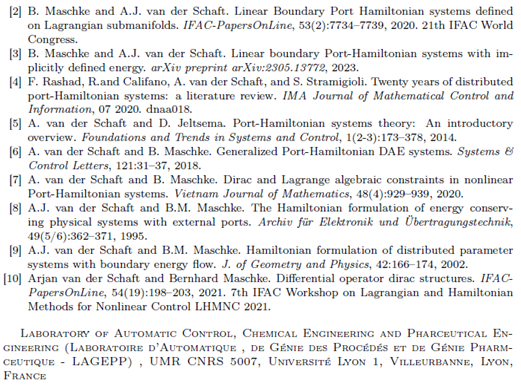Dr. Maschke, Bernhard
Automatic Control at the Laboratory of Control and Chemical Engineering
University Claude Bernard Lyon 1
Seminar Information

Boundary Port Hamiltonian Systems have been introduced in [9] as an extension of Hamiltonian systems defined with respect to Hamiltonian differential operators, to open systems which may interact with their environment through the boundary of their spatial domain and have led to numerous applications for their numerical simulation and their control [4]. In this talk, we shall present a novel class of Boundary Port Hamiltonian Systems for which the definition of the Hamiltonian functional, often representing the energy of physical systems, is replaced by the definition of the constitutive relations relating the energy and the co-energy variables which define the state space as some Lagrangian submanifold [6, 7, 3]. Throughout the talk, the example of elastic rods is used for which these constitutive relations include the, (possibly non-local) elasticity relations relating the strain and the stress variables.
In the first part, we recall the definition Port Hamiltonian systems defined on Dirac structures [8, 5] and their extension to infinite-dimensional systems, the Boundary Port Hamiltonian systems defined with respect to a Stokes-Dirac structure, derived from a Hamiltonian differential operator [9, 1]. We shall recall that, for physical systems, the Dirac structure represents the interconnection relation between the energy storing elements and with the environment of the system.
In the second part of the talk, we present a recent extension of Hamiltonian systems with state space defined as a Lagrange subspace of the cotangent space of some generalized configuration manifold [6, 7]. For physical systems this Lagrange manifold corresponds to the reciprocal constitutive relations between the energy and co-energy variables. Then we present their generalization to Port Hamiltonian systems on 1-dimensional spatial domains, where the reciprocal relations and the associated Stokes-Lagrange submanifold are defined by differential operators [3, 2, 10].
In the third part, we show how a Hamiltonian functional can be associated with a Stokes-Lagrange subspace, and how this leads to an energy balance equation involving the boundary variables of the Stokes-Dirac structure as well as of the Stokes-Lagrange subspace. And the extension to dissipative systems is shortly addressed.
We conclude with some opening to the generalization to nonlinear constitutive systems and multi-dimensional spatial domains.


Bernhard Maschke has graduated as engineer in telecommunications from the Ecole Nationale Superieure des Télécommunications, Paris, France, in 1984. He received his Ph.D. degree in Automatic Control in 1990 for his work on the control of robotic manipulators with flexible arms performed at the Advanced Robotics Engineering Unit of the Atomic Energy Commision (CEA) in Fontenay–aux–Roses, (France). He then received the Habilitation to Direct Research from the University of Paris-Sud, Orsay, France in 1998 for his work on Port Hamiltonian systems.
He has been Associate Professor at the Laboratory of Industrial Automation of the Conservatoire National des Arts et Métiers, Paris, France from 1990 until 2000. Since September 2000, he is Professor of Automatic Control at the Laboratory of Control and Chemical Engineering (LAGEP UMR CNRS 5007) of the University Claude Bernard Lyon 1, Villeurbanne, France.
His research interests concern the system’s theory and control of open and complex multi-physical systems. He contributed to the formulation of physical systems’ theory in terms of port-Hamiltonian systems and the development of passive controllers based on the assignment of the geometric structure in closed loop. His current research activity mainly concerns the geometric structure of Irreversible Thermodynamic systems, Boundary Port Hamiltonian systems defined on Lagrange submanifolds in finite and infinite-dimension and the optimal control based on the minimisation of the exergy and entropy creation.
